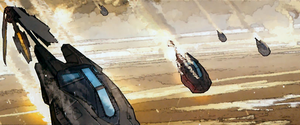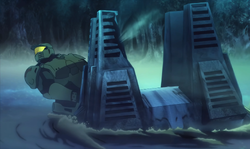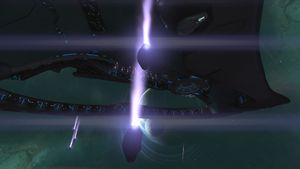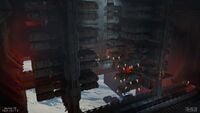Drop pod
From Halopedia, the Halo wiki

Drop pods are a kind of vehicle utilised for the purpose of deploying troops and materiel from an orbiting warship to the surface of a planet in a short amount of time. They are less commonly used than dropships due to their unconventional (and frequently disposable) nature.[1][2][3][4][5][6]
Human drop pods[edit]
Drop pods are common fixtures of the two primary human militaries of the galaxy; the United Nations Space Command and the Colonial Military Authority. Of these, the UNSC are particularly reliant on the use of drop pods thanks to the aptly-named Orbital Drop Shock Troopers; specialised shock troops who specialise in the use of drop pods to insert behind enemy lines and conduct special missions.[7][8] Although the ODSTs are the primary users of drop pod insertions in the UNSC, both Spartans and regular Marine forces may also use them.[9] The deployment and doctrine of drop pods is governed by UNSC Insertion Protocols.[7] Orbital drop pods were first developed by humanity during the early 22nd century, intended as a solution for "transorbital support interdiction". The first ODSTs were deployed onto Mars against Koslovic forces in the Interplanetary War of the 2160s, and drop pods have been a staple of the UNSC ever since - seeing use in both the Insurrection and the Human-Covenant War.[10][11]
Drop pod deployments have a lower overall attrition rate than a standard dropship insertion; this is due to each soldier being deployed individually rather than multiple in one craft. As such, even if anti-aircraft fire takes out several drop pods, it is still overall fewer casualties than dozens of soldiers being killed when a Pelican (or similar craft) is downed.[7][4][5][6] A typical ODST drop consists of dozens or hundreds of individual pods launched from an orbiting starship that is conducting evasive maneuvers, with an artificial intelligence (formally termed an expert system) controlling the vehicle's descent through the atmosphere to multiple predetermined landing zones on preset routes designed to maximise the pod's ability to evade enemy fire.[1][10] When launching, the pods have a thirty-second countdown that begins on the commanding officer's mark, before being ejected.[7] Depending on the vessel (such as the Halcyon-class and Marathon-class cruisers), this can take the form of a simple free drop,[12][13] while on others (such as the Stalwart-class light frigate) the pods are launched via magazine-fed coilgun launcher mounted in the ventral portion of the ship.[14] The pods spend the majority of their descent - generally only a few minutes - in free fall, before the pod's braking systems activate and guide the pod into its landing site.[8] The pods have a limited maneuvering ability, intended for adjusting the landing site and avoiding AA defences.[7] In some cases, ODSTs may deploy during a meteor shower over a planet, to help the pods disguise themselves among the naturally-falling rock burning up in the atmosphere.[15]
Once nearing the ground, drop pods activate a drag chute (more formally termed a "Drogue Panel"[10]) formed from the upper-most panels. The chute deploys and begins to slow down the pod's descent. Once about 1 kilometre (0.62 mi) from the ground, a series of computer-controlled retrothrusters engage and rapidly decelerate the pod such that it can impact safely.[10][Note 1] Once the pod hits the ground in a "controlled crash", the entrance hatch is blown off by a series of detonation charges, allowing the occupant to immediately exit the vehicle and enter combat.[1][8] A landed pod generally retains a small amount of rocket fuel internally; this is intended such that should the pod land in an unsuitable location, a soldier can reactivate the rockets and "hop" the pod to a better landing site.[16]
The drop pod's interior contains a single crash seat facing the exterior hatch, which has hardened and shielded communications equipment built into it. This equipment is used to feed information to the occupant during the drop and links the members of the ODST's combat team together. As such, while inside the pod, an ODST's helmet communications gear is redundant - and only necessary should the pod's own communications equipment fail.[7] The crash web has minimal inertial dampening and comfort features,[10] though more recent models have improved in this regard.[1] The exterior is an armoured carapace of Titanium-A armor;[10] if the exterior shell is damaged prior to, or during, the atmospheric entry phase of the operation, it can cause the entire pod to be destroyed. [7]
Variants[edit]
The design and manufacturing of drop pods has two major delineations; Single Occupant Exoatmospheric Insertion Vehicles/Vessels (SOEIVs) and Human Entry Vehicles (HEVs).[1]
- M7650 Human Entry Vehicle - an obsolete and unreliable drop pod still in service closer to the start of the Human-Covenant War.[1]
- M8823 Human Entry Vehicle - an older model entering service in 2461 and used by both the UNSC and CMA. Used in large numbers throughout the Insurrection and Human-Covenant War especially on vessels that do not carry dedicated ODST complements.[1]
- M8900 Single Occupant Exoatmospheric Independent Entry Vehicle - a high-speed drop pod preferred by ODST units through the later years of the Human-Covenant War.[1]
- M9407 Single Occupant Exoatmospheric Independent Entry Vehicle - a modern drop pod introduced in the post-war era outfitted with advanced technologies, and utilised by both ODSTs and Spartans.[1]
The UNSC also makes use of other, more unique kinds of drop pod. These include stealth-capable slipspace insertion pods which can be fired from a ship inside slipspace at a target world,[17] and even the use of regular escape pods for extreme circumstances.[18][19] ODST commanders's pods are equipped with more equipment than their standard counterparts; these include a fourth-generation dumb AI, high-powered imaging gear, tactical sensors,[7] sensor drones, and a battlenet relay.[10] These can be used by the commander to plan out their attack for once they land.[20]
For logistics, equipment drop pods can also be used to deploy weapons, equipment, and even light vehicles (such as a Mongoose) to the battlefield.[16] These kinds of logistics pods include both smaller dropship-carried ordnance pods and larger SOEIV/HEV-style orbital insertion pods. Regular drop pods are equipped with a cache of extra weapons, ammunition, and other supplies; once landed, it's the ODST's job to strip their pod of supplies and then haul them to a newly-established Forward Operating Base.[7][10]
Covenant drop pods[edit]
The Covenant have a long history of drop pod use, dating back to San'Shyuum Reformist pods used during the War of Beginnings[21] to several designs used during the empire in the Human-Covenant War and by its remnants in the post-war years.[22] Drop pods are some of the most varied of all Covenant transportation methods, and are so varied that humanity has only begun to scratch the surface of their various differing formats.[23] Their various design patterns are broken into a number of lineages and manufacturing templates that have been passed down for generations.[22] Some (such as the Suspa Al-pattern Assault Carapace) may even be highly exclusive designs restricted to select warrior orders, with their requisition restricted and the secrets of their manufacture jealously guarded.[24]
Unlike the UNSC's deployment methodology, the Covenant use their drop pods primarily for massed "meteoric assaults" rather than the strategic goals more characteristic of the ODSTs.[24] They are generally deployed at the strategic discretion of a given shipmaster without a consistent overall strategem - launched from spacecraft high above a planet with one primary objective in mind - assault.[22] Covenant single-occupant drop pods are typically designed with Sangheili ergonomics in mind,[24][22] and the warriors selected to deploy in a meteoric assault are some of the most unshakeable and bloodthirsty available to the Covenant. They are often drawn from the ranks of the Zealot orders (or from those aspiring to their membership), and are deployed with the expectation that they will be the only one to survive their assault. As such, their duties are simple; complete their mission or die trying. While this challenge is relished by Sangheili, it is more reluctantly undertaken by the Covenant's other species.[24] Evocati and Special Operations forces may also deploy via drop pods.[25][26][27]
Unlike the preset and AI-guided drops of humanity, Covenant drop pods are fitted with control suites to allow the warrior(s) within to manually guide the pod into landing. They are fitted with compact, high-thrust impulse drives that can be used to perform evasive maneuvers and braking actions.[24] The violent effect of this rapid deceleration assists in disorienting enemies close to the impact site, and allows the warrior within the pod the element of shock to assist in their initial deployment.[28] Similarly to escape pods, they may be fitted with door-mounted stasis fields that provide inertial compensation and prevent the occupant from being injured or killed during their brief transit from space to ground.[24]
Drop pods launched from under the veil of a warship's stealth shroud gain a temporary signature reduction while passing through the field.[29]
Variants[edit]
- Types
Under the Covenant's system of design patterns, drop pods are delineated into one of a number of carapace type, each reflecting the intended use case of the drop pod. Known carapace types include:
- Assault Carapace
- Breaching Carapace - breaching carapaces are intended to breach planetary and shipboard defences with discretion and speed.[23]
- Intrusion Carapace -
The carapace terminology was seemingly inherited by the UNSC and used in their own type-designations, albeit with some modifications.[23][28]
- Single occupant
- Suspa Al-pattern Assault Carapace
- Udka-pattern Assault Carapace
- Kalu'teh-pattern Breaching Carapace
- Gloto-pattern Breaching Carapace
- Yado-pattern Intrusion Carapace
- Unidentified pattern
- Multiple occupant
- Gloto'kas-pattern Assault Carapace (resuable)
- Gloto'kef-pattern Assault Carapace
- Yado'kef-pattern Assault Carapace
- Kalu'qeh-pattern Breaching Carapace
Banished drop pods[edit]
The Banished make use of drop pods of their own design. The primary variant used is the Gydrozka Workshop Breaching Pod, which can be deployed from various warships including dreadnoughts and karves.[30][31] The Banished drop pod deployment metholodogy is designed to emphasise speed and shock value, with the goal of intentionally impacting in as violent a manner as possible to disorient enemies near to the landing site. This design is goal is reflected in the vehicle's heavily armoured frame, designed not to protect the occupant but instead to inflict damage to opposition caught in the way.[30]
Banished dreadnoughts are also outfitted with complements of drop-bases - a similar concept to the drop pod, but on a much larger scale. Modular drop-bases are designed to allow the Banished to furnish the invasion of an enemy planet with equipment according to the invading force's needs. Drop-bases are used to ferry in initial landings of infrastructure and resources to allow a Banished contingent to establish a beachhead before the establishment of a larger, more permanent outpost facility.[32]
A Jiralhanae Captain in front of a Gydrozka pod.
Flood dispersal pods[edit]
While not a drop pod in the traditional sense, Flood dispersal pods are living infection forms utilised by the Flood parasite to facilitate the spread of the infection from world to world. They are grown to act as disposable containers for combat forms, pure forms, and spores - shielding the occupants during orbital insertions and bursting apart on contact with the surface. They can be deployed from an infected warship in orbit or expelled from Flood hives on the ground via gas discharges.[33]
A Flood dispersal pod in flight over Installation 08.
Trivia[edit]

|
Browse more images in this article's gallery page. |
- The United States' Defense Advanced Research Projects Agency (DARPA) is currently working on project SUSTAIN, codenamed "Hot Eagle". The project's aim is to have heavily armed United States Marines launched into suborbital space and then re-enter anywhere on Earth in less than a total of two hours. Specifications have not yet been revealed to the public.
- The concept of dropping individual soldiers onto a planet from orbit in pods was popularized by Robert A. Heinlein's novel Starship Troopers. SOEIVs in the Halo universe act similarly to those described in the book. The ODST and the book's Mobile Infantry share the doctrine that officers should be into combat deployed ahead of enlisted personnel. Additionally, the ODST tradition of playing the ODST anthem prior to a drop is similar to Mobile Infantry traditions in Starship Troopers, with the anthem of the unit's respective troop ship played on their radios during mid drop.
- In Halo Wars, Captain Cutter's special ability allows the player to drop an entire squad of ODSTs in a single pod. While it is possible that UNSC Spirit of Fire uses larger drop pods that can deploy multiple troopers, the requisitioned troopers arrive within about a second and land exactly on target. Indeed, it is possible to land dozens of squads within mere meters of each other over the span of a few seconds; this is merely a gameplay conceit, as realistically representing the logistics of ODST deployment would severely disrupt the flow of gameplay.
Notes[edit]
- ^ The Halo 3: ODST Field Guide entry on the SOIEV notes that the retrothrusters engage once the pod is 50 metres (160 ft) from the ground. This may be difference based on model, though this article has chosen to follow the more recent source.
Sources[edit]
- ^ Jump up to: a b c d e f g h i Halo Encyclopedia (2022 edition), page 150-151
- ^ Halo Waypoint, UNSC Drop Pods (Retrieved on Oct 27, 2015) [archive]
- ^ Halo Waypoint, The New Halo Encyclopedia is Out Today: "DROP POD - Small reentry vehicle used to transport combat troops from planetary orbit to the surface." (Retrieved on Dec 19, 2022) [archive]
- ^ Jump up to: a b Halo: The Essential Visual Guide, page 52
- ^ Jump up to: a b Halo Encyclopedia (2009 edition), page 58-59
- ^ Jump up to: a b Halo Encyclopedia (2011 edition), page 60-61
- ^ Jump up to: a b c d e f g h i Bungie.net, Halo 3 ODST : Field Guide - SOEIV (Retrieved on May 25, 2013) [local archive] [external archive]
- ^ Jump up to: a b c Halo Encyclopedia (2022 edition), page 58-59
- ^ Halo Waypoint, Drop Pod (Retrieved on Mar 25, 2012) [local archive] [external archive]
- ^ Jump up to: a b c d e f g h Halo: Warfleet, page 50-51
- ^ Halo Waypoint, ODST (Retrieved on Oct 27, 2015) [archive]
- ^ Halo 3: ODST, campaign level Prepare to Drop
- ^ Halo: Fireteam Raven, campaign level Escape
- ^ Halo: Warfleet, page 36-37
- ^ Halo Legends, episode The Babysitter
- ^ Jump up to: a b Halo: The Cole Protocol, chapter 62
- ^ Halo: Ghosts of Onyx, Prologue
- ^ Halo 4, campaign level Dawn
- ^ Halo Wars 2, ODST in-game drop pod model
- ^ Halo: The Flood, chapter 2
- ^ Halo: Broken Circle, Prologue
- ^ Jump up to: a b c d Halo Encyclopedia (2022 edition), page 284-285
- ^ Jump up to: a b c Halo 4: The Essential Visual Guide, page 121
- ^ Jump up to: a b c d e f Halo: Warfleet, page 66-67
- ^ Halo Waypoint, Canon Fodder - Log of War (Retrieved on Jun 15, 2021) [archive]
- ^ Halo 2, campaign level Outskirts
- ^ Halo 3, campaign level Floodgate
- ^ Jump up to: a b Halo Waypoint, Covenant Drop Pods (Retrieved on Dec 4, 2015) [archive]
- ^ Halo: Warfleet, page 76-77
- ^ Jump up to: a b Halo Encyclopedia (2022 edition), page 472
- ^ Halo: Outcasts, chapter 24
- ^ Halo Encyclopedia (2022 edition), page 462
- ^ Halo Encyclopedia (2022 edition), page 407



















